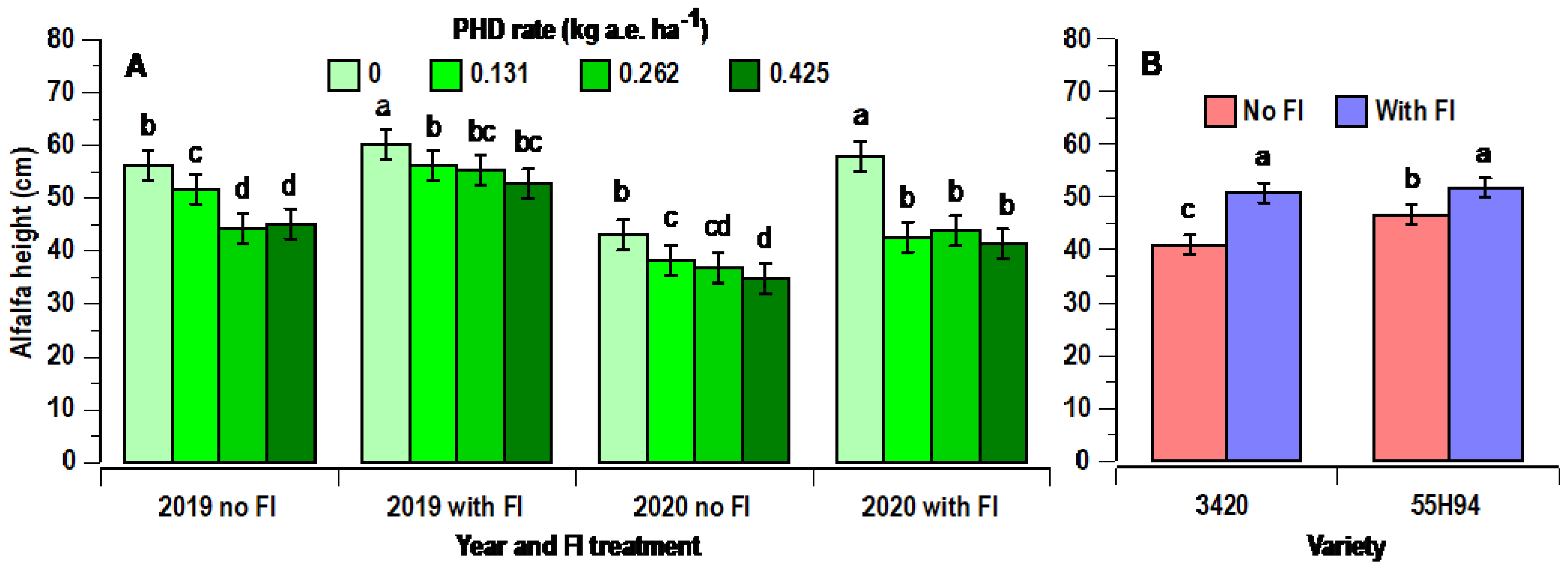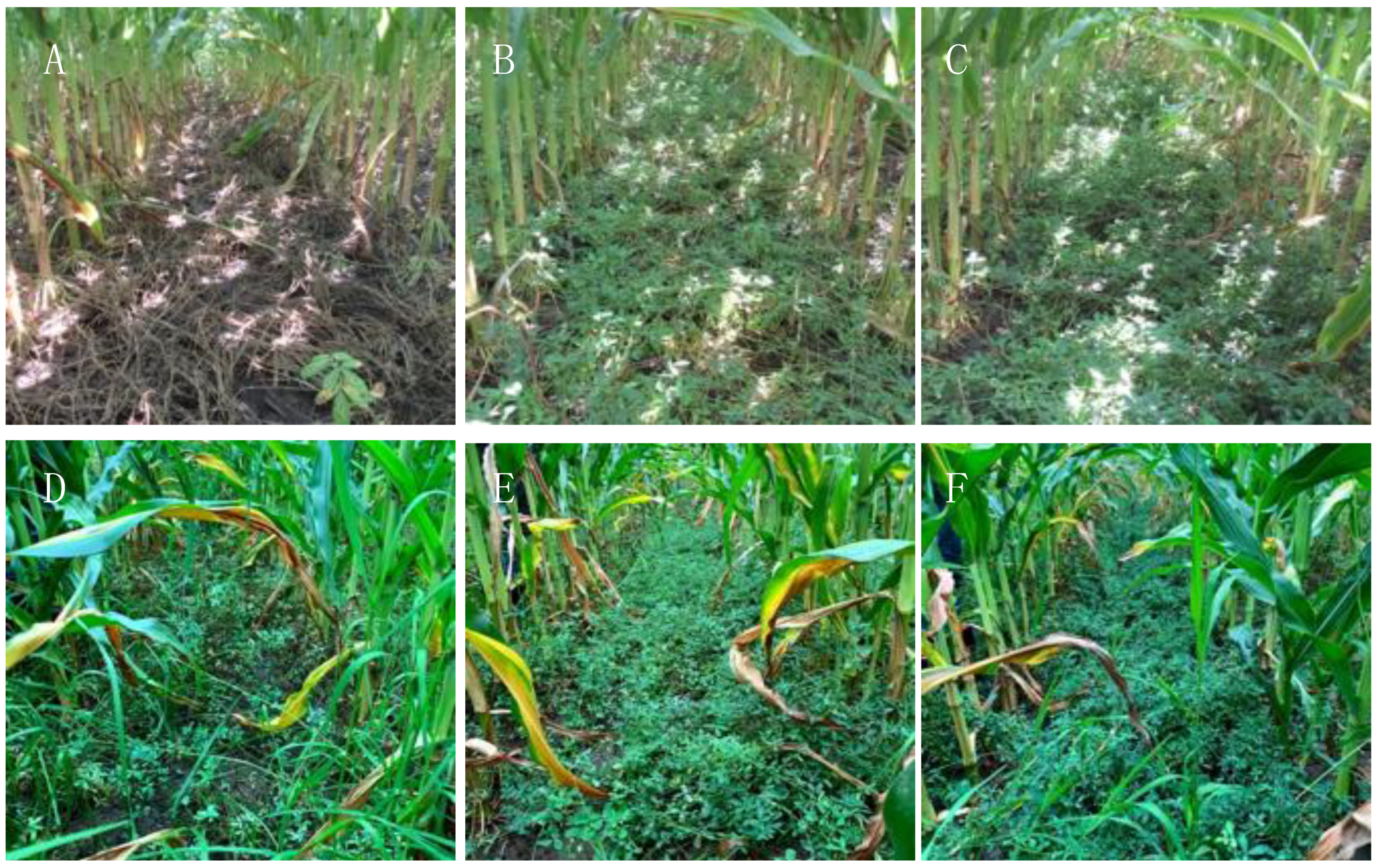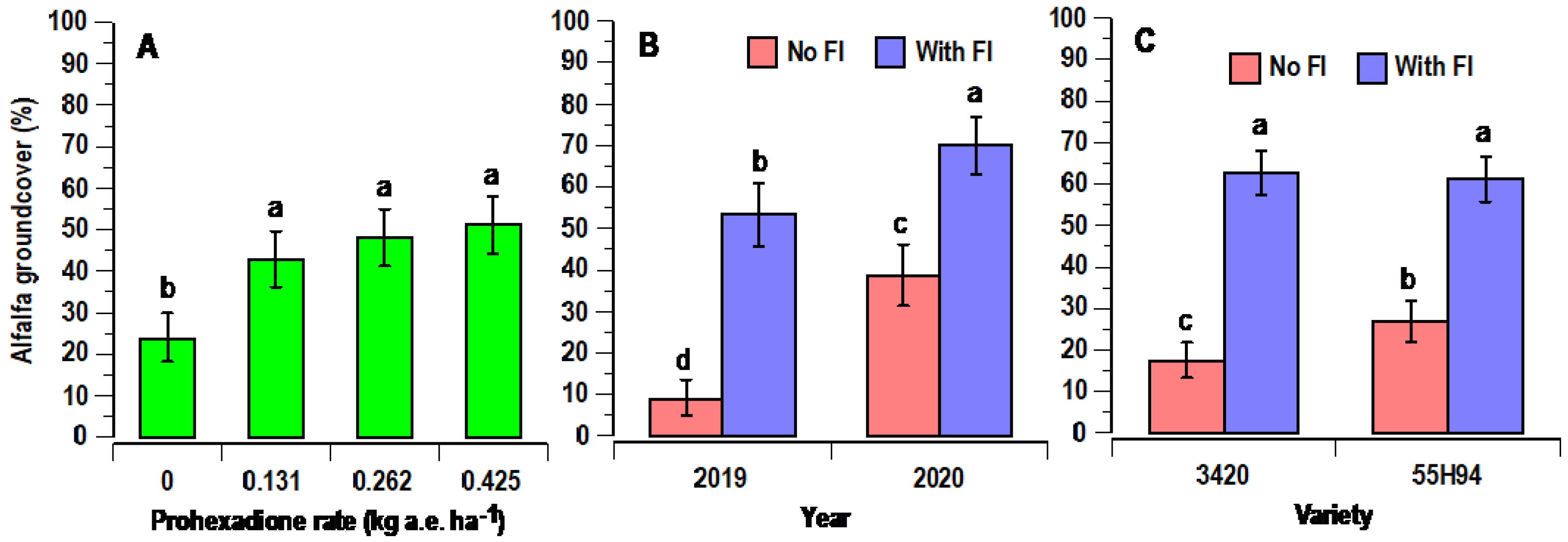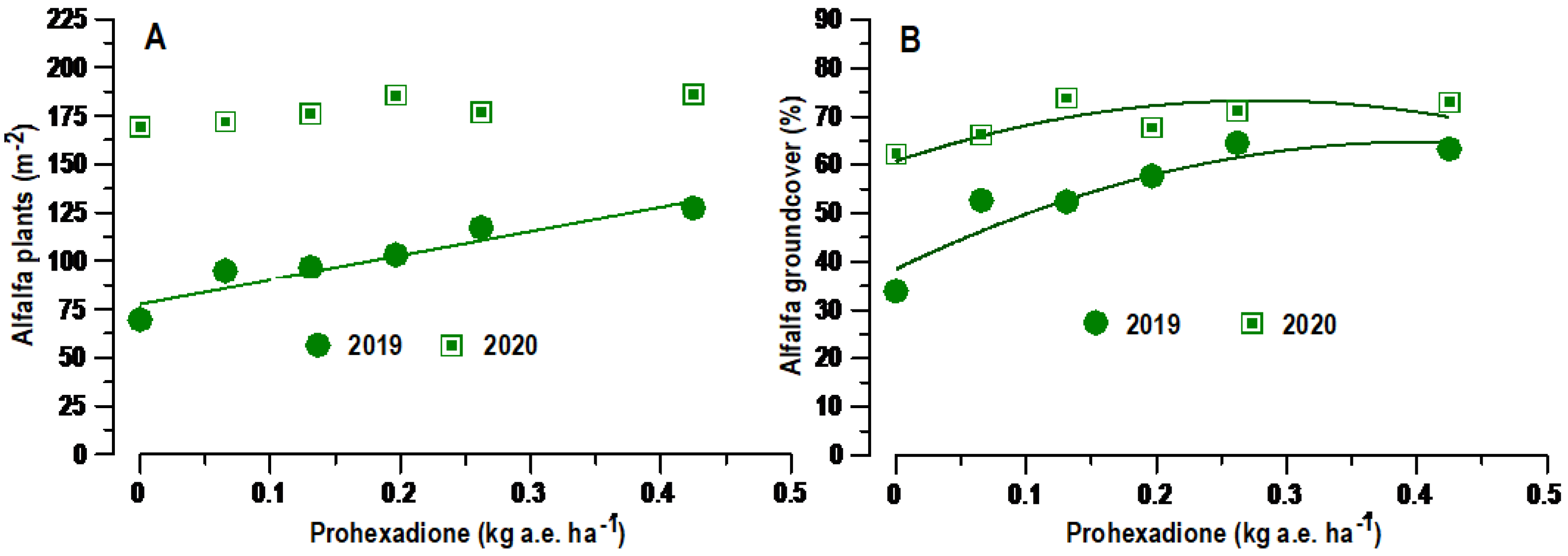Establishment of Alfalfa Intercropped under Corn in Response to Varying Rates of Prohexadione with or without Fungicide Plus Insecticide
Abstract
:1. Introduction
2. Materials and Methods
2.1. Sites and Crop Management
2.2. Alfalfa Measurements and Statistical Analyses
3. Results and Discussion
3.1. Weather Conditions, Corn Silage Competitiveness, and PLH Populations
3.2. Plant Height and Foliar Health of Interseeded Alfalfa
3.3. Stand Density and Groundcover of Alfalfa Following Establishment
4. Conclusions
Supplementary Materials
Author Contributions
Funding
Data Availability Statement
Acknowledgments
Conflicts of Interest
References
- Grabber, J.H.; Osterholz, W.R.; Bjorneburg, D.L.; Riday, H.; Dias, J.L.C.S.; Patel, S.; Smith, D.L.; Ruark, M.D.; Cassida, K.A.; Burns, E.E.; et al. Intercropping alfalfa with corn silage. In Proceedings of the World Alfalfa Congress, San Diego, CA, USA, 14–17 November 2022; Available online: https://alfalfasymposium.ucdavis.edu/+symposium/proceedings/2022/Articles/John-Grabber-2022-Intercropping-Alfalfa-With-Corn-Silage.pdf (accessed on 6 November 2023).
- Franco, J.G.; Berti, M.T.; Grabber, J.H.; Hendrickson, J.R.; Nieman, C.C.; Pinto, P.; Van Tassel, D.; Picasso, V.D. Ecological intensification of food production by integrating forages. Agronomy 2021, 11, 2580. [Google Scholar] [CrossRef]
- Grabber, J.H.; Smith, D.L.; Osterholz, W.R.; Renz, M.J. Establishment and first year yield of interseeded alfalfa as influenced by corn plant density and treatment with prohexadione, fungicide and insecticide. Agronomy 2021, 11, 243. [Google Scholar] [CrossRef]
- Bekheta, M.A.; Abdelhamid, M.T.; El-Morsi, A.A. Physiological response of Vicia faba to prohexadione-calcium under saline conditions. Planta Daninha Viçosa-MG 2009, 27, 769–779. [Google Scholar] [CrossRef]
- Rademacher, W. Chemical regulators of gibberellin status and their application in plant production. In Annual Plant Reviews; Hedden, P., Thomas, S.G., Eds.; John Wiley & Sons: Hoboken, NJ, USA, 2017; Volume 49, pp. 359–403. [Google Scholar]
- Rademacher, W.; Spinelli, F.; Costa, G. Prohexadione-Ca: Modes of action of a multifunctional plant bioregulator for fruit trees. Acta Hort. 2006, 727, 97–106. [Google Scholar] [CrossRef]
- Reekie, J.Y.; Hicklenton, P.R.; Struik, P.C. Prohexadione-calcium modifies growth and increases photosynthesis in strawberry nursery plants. Can. J. Plant Sci. 2005, 85, 671–677. [Google Scholar] [CrossRef]
- Grabber, J.H.; Osterholz, W.R.; Riday, H.; Cassida, K.A.; Williamson, J.A.; Renz, M. Differential survival of alfalfa varieties interseeded into corn silage. Crop Sci. 2021, 61, 1797–1808. [Google Scholar] [CrossRef]
- Grabber, J.H. Prohexadione-calcium improves stand density and yield of alfalfa interseeded into silage corn. Agron. J. 2016, 108, 726–735. [Google Scholar] [CrossRef]
- Osterholz, W.R.; Renz, M.J.; Lauer, J.G.; Grabber, J.H. Prohexadione-calcium rate and timing effects on alfalfa interseeded into silage corn. Agron. J. 2018, 110, 85–94. [Google Scholar] [CrossRef]
- Emery, K.M.; English, J.T. Development of foliar diseases of alfalfa in relation to microclimate, host growth, and fertility. Phytopathology 1994, 84, 1263–1269. [Google Scholar] [CrossRef]
- Nutter, F.W., Jr.; Guan, J.; Gotlieb, A.R.; Rhodes, L.H.; Grau, C.R.; Sulc, R.M. Quantifying alflafa yield losses caused by foliar diseases in Iowa, Ohio, Wisconsin, and Vermont. Plant Dis. 2002, 86, 269–277. [Google Scholar] [CrossRef]
- Bucciarelli, B.; Xu, Z.Y.; Ao, S.; Cao, Y.Y.; Monteros, M.J.; Topp, C.N.; Samac, D.A. Phenotyping seedlings for selection of root system architecture in alfalfa (Medicago sativa L.). Plant Methods 2021, 17, 125. [Google Scholar] [CrossRef] [PubMed]
- Pearson, C.H.; Brummer, J.E.; Beahm, A.T.; Hansen, N.C. Kura Clover Living Mulch for Furrow-Irrigated Corn in the Intermountain West. Agron. J. 2014, 106, 1324–1328. [Google Scholar] [CrossRef]
- Hansen, J.L.; Miller-Garvin, J.E.; Waldron, J.K.; Viands, D.R. Comparison of potato leafhopper-resistant and susceptible alfalfa in New York. Crop Sci. 2002, 42, 1155–1163. [Google Scholar] [CrossRef]
- Sulc, R.M.; McCormick, J.S.; Hammond, R.B.; Miller, D.J. Forage yield and nutritive value responses to insecticide and host resistance in alfalfa. Crop Sci. 2015, 55, 1346–1355. [Google Scholar] [CrossRef]
- Grabber, J.H.; Riday, H.; Enjalbert, N.; Wagner, S.; Mickelson, D. Establishment of alfalfa interseeded into corn in response to one cycle of selection and hybridization. Crop Sci. 2023, 63, 1139–1147. [Google Scholar] [CrossRef]
- Laboski, C.A.M.; Peters, J.B. Nutrient Application Guidelines for Field, Vegetable, and Fruit Crops in Wisconsin. A2809; Cooperative Extension Publications, University of Wisconsin-Extension: Madison, WI, USA, 2012. [Google Scholar]
- Osterholz, W.R.; Dias, J.L.C.S.; Grabber, J.H.; Renz, M.J. PRE- and POST-applied herbicide options for alfalfa interseeded with corn silage. Weed Technol. 2021, 35, 263–270. [Google Scholar] [CrossRef]
- Osterholz, W.R.; Grabber, J.H.; Renz, M.J. Adjuvants for prohexadione-calcium applied to alfalfa interseeded into corn. Agron. J. 2018, 110, 2687–2690. [Google Scholar] [CrossRef]
- Piepho, H.P.; Edmondson, R.N. A tutorial on the statistical analysis of factorial experiments with qualitative and quantitative treatment factor levels. J. Agron. Crop Sci. 2017, 204, 429–455. [Google Scholar] [CrossRef]
- Berti, M.T.; Lukaschewsky, J.; Samarappuli, D.P. Intercropping alfalfa into silage maize can be more profitable than maize silage followed by spring-seeded alfalfa. Agronomy 2021, 11, 1196. [Google Scholar] [CrossRef]
- Kaur, H.; DiFonzo, C.; Chilvers, M.; Cassida, K.A.; Singh, M.P. Hybrid insect protection and fungicide application for managing ear rots and mycotoxins in silage corn. Agron. J. 2023, 115, 1957–1971. [Google Scholar] [CrossRef]
- Reed, H.; Mueller, B.; Groves, C.L.; Smith, D.L. Impact of foliar fungicides on disease and silage quality of brown midrib corn hybrids in Wisconsin. Plant Health Progress 2021, 22, 503–508. [Google Scholar] [CrossRef]
- Undersander, D.; Renz, M.; Sheaffer, C.; Shewmaker, G.; Sulc, M. Alfalfa Management Guide; ASA: Madison, WI, USA; CSSA: Madison, WI, USA; SSSA: Madison, WI, USA, 2015. [Google Scholar]
- Tesar, M.B.; Marble, V.L. Alfalfa establishment. In Alfalfa and Alfalfa Improvement; Hanson, A.A., Barnes, D.K., Hill, J.R.R., Eds.; ASA: Madison, WI, USA; CSSA: Madison, WI, USA; SSSA: Madison, WI, USA, 1988; pp. 303–332. [Google Scholar]







Disclaimer/Publisher’s Note: The statements, opinions and data contained in all publications are solely those of the individual author(s) and contributor(s) and not of MDPI and/or the editor(s). MDPI and/or the editor(s) disclaim responsibility for any injury to people or property resulting from any ideas, methods, instructions or products referred to in the content. |
© 2023 by the authors. Licensee MDPI, Basel, Switzerland. This article is an open access article distributed under the terms and conditions of the Creative Commons Attribution (CC BY) license (https://creativecommons.org/licenses/by/4.0/).
Share and Cite
Grabber, J.H.; Dias, J.L.C.S.; Renz, M.J. Establishment of Alfalfa Intercropped under Corn in Response to Varying Rates of Prohexadione with or without Fungicide Plus Insecticide. Agronomy 2023, 13, 2823. https://doi.org/10.3390/agronomy13112823
Grabber JH, Dias JLCS, Renz MJ. Establishment of Alfalfa Intercropped under Corn in Response to Varying Rates of Prohexadione with or without Fungicide Plus Insecticide. Agronomy. 2023; 13(11):2823. https://doi.org/10.3390/agronomy13112823
Chicago/Turabian StyleGrabber, John H., José Luiz C. S. Dias, and Mark J. Renz. 2023. "Establishment of Alfalfa Intercropped under Corn in Response to Varying Rates of Prohexadione with or without Fungicide Plus Insecticide" Agronomy 13, no. 11: 2823. https://doi.org/10.3390/agronomy13112823
APA StyleGrabber, J. H., Dias, J. L. C. S., & Renz, M. J. (2023). Establishment of Alfalfa Intercropped under Corn in Response to Varying Rates of Prohexadione with or without Fungicide Plus Insecticide. Agronomy, 13(11), 2823. https://doi.org/10.3390/agronomy13112823





